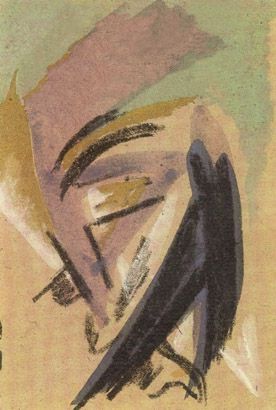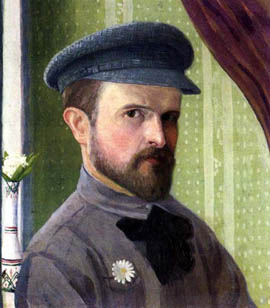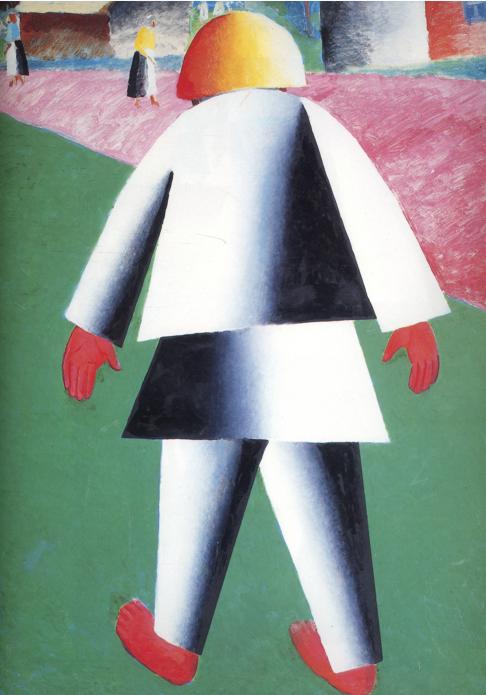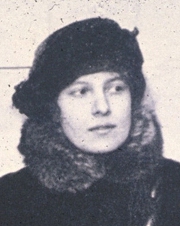|
Verbovka
Verbovka Village Folk Centre was an artisan cooperative in the village of Verbovka founded by Natalia Davidova in the Ukrainian province of Kiev. Natalia Davidova, one of the founders and the head of the Kiev Folk Center, was an Avant-garde artist descended from the ancient Ukrainian Hudim-Levkovichis family (Russian philosopher Nikolai Berdyaev was her cousin and artist Nina Genke-Meller was his sister-in-law). The beginning of the cooperation of Natalia Davidova and Nina Genke-Meller originated not just from their family relations. They both were keen on folk art and were devoted to the idea of implementation of Avant-garde artistic principles into practice of amateur goods. In 1915 Nina Genke became a head and chief artist of Natalia's Davidova Folk Center in Verbovka village. N.Davidova involved Nina Genke in "promoting " folk thing's production in accordance with the sketchers of famous Avant-garde artists. The members of the '' Supremus'' group started to cooperate very ac ... [...More Info...] [...Related Items...] OR: [Wikipedia] [Google] [Baidu] |
Olga Rozanova
Olga Vladimirovna Rozanova (also spelled Rosanova, Russian: Ольга Владимировна Розанова) (22 June 1886 – 7 November 1918, Moscow) was a Russian avant-garde artist painting in the styles of Suprematism, Neo-Primitivism, and Cubo-Futurism. Biography Early life Olga Rozanova was born in Melenki, a small town near Vladimir. Her father, Vladimir Rozanov, was a district police officer and her mother, Elizaveta Rozanova, was the daughter of an Orthodox priest. She was the family's fifth child; she had two sisters, Anna and Alevtina, and two brothers, Anatolii and Vladimir. Rozanova's father died in 1903, and her mother became the head of the household. She graduated from the Vladimir Women's Gymnasium in 1904. Due to her interest in the avant-garde movement, she moved to Moscow to study painting. Artistic career After arriving in Moscow, she attended the Bolshakov Art School, where she worked under Nikolai Ulyanov and sculptor Andrey Matveev. She aud ... [...More Info...] [...Related Items...] OR: [Wikipedia] [Google] [Baidu] |
Nina Genke-Meller
Nina Henrichovna Genke or Nina Henrichovna Genke-Meller, or Nina Henrichovna Henke-Meller (russian: Нина Генке-Меллер, Нина Генке; 19 April 1893 – 25 July 1954) was a Ukrainian-Russian avant-garde artist, (Suprematist, Futurist), designer, graphic artist and scenographer. Biography Nina Genke was born in Moscow in 1893 to a Dutch father, Genrikh Genke, and a Russian mother, Nadezhda Tikhanova. She married the artist Vadym Meller (1884-1962). Nina Genke-Meller died in Kyiv in 1954. Education In 1912 she graduated from Levandovskaya Private Gymnasium in Kyiv. She received a title to teach Russian language and history. The following year she began teaching history, geography and drawing at the Higher Primary College for Women in . In Skoptsi, she met the artist Yevgenia Pribylska who headed the Art Studio in a Folk Center and became more inspired to become an artist herself. In 1914 Genke began attending Aleksandra Ekster’s studio in Kyiv for her a ... [...More Info...] [...Related Items...] OR: [Wikipedia] [Google] [Baidu] |
Liubov Popova
Lyubov Sergeyevna Popova (russian: Любо́вь Серге́евна Попо́ва; April 24, 1889 – May 25, 1924) was a Russian-Soviet avant-garde artist, painter and designer. Early life Popova was born in Ivanovskoe, near Moscow, to the wealthy family of Sergei Maximovich Popov, a very successful textile merchant and vigorous patron of the arts, and Lyubov Vasilievna Zubova, who came from a highly cultured family. Lyubov Sergeyevna had two brothers and a sister: Sergei was the eldest, then Lyubov, Pavel and Olga. Pavel became a philosopher and the guardian of his sister's artistic legacy.Dabrowski, M., ''Liubov Popova'', Museum of Modern Art, New York, 1991, p.122. Popova grew up with a strong interest in art, especially Italian Renaissance painting. At eleven years old she began formal art lessons at home; she was first enrolled in Yaltinskaia's Women's Gymnasium, then in Arseneva's Gymnasium in Moscow. By the age of 18 she was studying with Stanislav Zhukovsky, and ... [...More Info...] [...Related Items...] OR: [Wikipedia] [Google] [Baidu] |
Ivan Kliun
Ivan Vasilievich Kliun, or Klyun, born Klyunkov (Russian: Иван Васильевич Клюн; 1 September 1873, Bolshiye Gorky, Petushinsky District - 13 December 1943, Moscow) was a Russian Avant-Garde painter, sculptor and art theorist, associated with the Suprematist movement. Biography His father was a carpenter. In 1881, seeking to improve their economic condition, the family moved to Kyiv. In 1890, they moved again, to Russian Poland. He received his initial artistic education at the in Warsaw, in the 1890s, while working as an accountant. In 1898, he relocated to Moscow, where he frequented the studios of and Ilya Mashkov. His most important contact, however, came in 1907 when he met Kazimir Malevich and was introduced to the Russian Avant-Garde. This influenced him profoundly, although he joined the when it was created in 1910 and remained a member until 1916. He originally worked in the Symboloist style but, in 1913, due to the influence of Malevich, he began e ... [...More Info...] [...Related Items...] OR: [Wikipedia] [Google] [Baidu] |
Supremus
Supremus (; 1915–1916) was a group of Russian avant-garde artists led by the "father" of Suprematism, Kazimir Malevich. It has been described as the first attempt to found the Russian avant-garde movement as an artistic entity within its own historical development. Supremus conceptualized the artist as one who has freed himself from everything that pre-decided the ideal structure of life and art. Malevich projected the Supremus vision onto Cubism, which he believed deconstructs things and completely changes the reference points of art. To support the movement, Malevich established the journal ''Supremus'' (initially titled ''Nul'' or ''Nothing''), which received contributions from artists and philosophers. The publication, however, never took off and its first issue was never distributed due to the Russian Revolution. Members of the group included Aleksandra Ekster, Liubov Popova, Olga Rozanova, Ivan Kliun, Ivan Puni, Nadezhda Udaltsova, Nina Genke-Meller, Ksenia Boguslavskaya ... [...More Info...] [...Related Items...] OR: [Wikipedia] [Google] [Baidu] |
Suprematism
Suprematism (russian: Супремати́зм) is an early twentieth-century art movement focused on the fundamentals of geometry (circles, squares, rectangles), painted in a limited range of colors. The term ''suprematism'' refers to an abstract art based upon "the supremacy of pure artistic feeling" rather than on visual depiction of objects. Founded by Russian artist Kazimir Malevich in 1913, Supremus ( Russian: Супремус) conceived of the artist as liberated from everything that pre-determined the ideal structure of life and art. Projecting that vision onto Cubism, which Malevich admired for its ability to deconstruct art, and in the process change its reference points of art, he led a group of Ukrainian and Russian avant-garde artists — including Aleksandra Ekster, Liubov Popova, Olga Rozanova, Ivan Kliun, Ivan Puni, Nadezhda Udaltsova, Nina Genke-Meller, Ksenia Boguslavskaya and others — in what's been described as the first attempt to independently foun ... [...More Info...] [...Related Items...] OR: [Wikipedia] [Google] [Baidu] |
Kazimir Malevich
Kazimir Severinovich Malevich ; german: Kasimir Malewitsch; pl, Kazimierz Malewicz; russian: Казими́р Севери́нович Мале́вич ; uk, Казимир Северинович Малевич, translit=Kazymyr Severynovych Malevych ., group=nb (Запись о рождении в метрической книге римско-католического костёла св. Александра в Киеве, 1879 год // ЦГИАК Украины, ф. 1268, оп. 1, д. 26, л. 13об—14. – 15 May 1935) was a ... [...More Info...] [...Related Items...] OR: [Wikipedia] [Google] [Baidu] |
Nadezhda Udaltsova
Nadezhda Andreevna Udaltsova (, 29 December 1885 – 25 January 1961) was a Russian avant-garde artist (Cubist, Suprematist), painter and teacher. Early life and education Nadezhda Udaltsova was born in the village of Orel, Russia, on 29 December 1885. When she was six, her family moved to Moscow, where she graduated from high school and began her artistic career. In September 1905 Udaltsova enrolled in the art school run by Konstantin Yuon and Ivan Dudin, where she studied for two years and met fellow-students Vera Mukhina, Liubov Popova, and Aleksander Vesnin. In the spring of 1908 she traveled to Berlin and Dresden, and upon her return to Russia, she unsuccessfully applied for admission to the Moscow Institute of Painting, Sculpture, and Architecture. She also married Alexander Udaltsov, her first husband, in 1908. In 1910–11, Udaltsova studied at several private studios, among them Vladimir Tatlin's. In 1912–13 she and Popova traveled to Paris to continue their studie ... [...More Info...] [...Related Items...] OR: [Wikipedia] [Google] [Baidu] |
Ivan Puni
Ivan Albertovich Puni (russian: Иван Альбертович Пуни; also known as Jean Pougny; 20 February 1892 – 28 December 1956) was a Russian avant-garde artist (Suprematist, Cubo-Futurist). Biography Early life Ivan Puni was born in Kuokkala (then Grand Duchy of Finland in the Russian Empire, now Repino in Russia) to a family of Italian origins. He was the grandson of an eminent Italian composer of ballet music, Cesare Pugni. His father, a cellist, insisted that he follow a military career, but Ivan instead decided to take private drawing lessons with Ilya Repin. By 1909, he had his own studio. Career Puni continued his formal training in Paris in 1910–11 at the Académie Julien and other schools, where he painted in a derivative ''fauviste'' style. Upon his return to Russia in 1912, he married fellow artist Kseniya Boguslavskaya, and met, and exhibited with, members of the St Petersburg avant-garde, including Kazimir Malevich and Vladimir Tatlin. He made a secon ... [...More Info...] [...Related Items...] OR: [Wikipedia] [Google] [Baidu] |
Ksenia Boguslavskaya
Kseniya (or Ksenia or Xenia) Boguslavskaya (russian: Ксения Богуславская, 24 January 1892 – 3 May 1972) was a Russian avant-garde artist (Futurist, Suprematist), poet and interior decorator. Her husband Ivan Puni was also a painter. She seems to be the originator of the Mavva (symbol of the World Evil) featured in poems written by Velimir Khlebnikov. Career Born in St. Petersburg, she studied art in Paris from 1911 to 1913. She returned to St. Petersburg in 1913 and married Ivan Puni. Their apartment in St Petersburg became a meeting place for avant-garde artists and poets. With Puni she published the cubo-futurist booklet ''Roaring Parnassus'' («Рыкающий Парнас») in 1914. During the year 1915, Boguslavskaya joined the ''Supremus'' («Супремус»), a group of avant-garde artists. Some group members included (Liubov Popova, Nadezhda Udaltsova, Varvara Stepanova, Aleksandra Ekster, Ivan Kliun, Nina Genke-Meller, Ivan Puni and ot ... [...More Info...] [...Related Items...] OR: [Wikipedia] [Google] [Baidu] |
Artist Cooperatives
An artist cooperative (also co-operative or co-op) is an autonomous visual arts organization, enterprise, or association jointly owned and democratically controlled by its members. Artist cooperatives are legal entities organized as non-capital stock corporations, non-profit organizations, or unincorporated associations. Such cooperatives typically provide professional facilities and services for its artist-members, including studios, workshops, equipment, exhibition galleries, and educational resources. By design, all economic and non-economic benefits and liabilities of the cooperative are shared equally among its members. Cooperative members elect their board of directors from within the membership. . See also * |
European Artist Groups And Collectives
European, or Europeans, or Europeneans, may refer to: In general * ''European'', an adjective referring to something of, from, or related to Europe ** Ethnic groups in Europe ** Demographics of Europe ** European cuisine, the cuisines of Europe and other Western countries * ''European'', an adjective referring to something of, from, or related to the European Union ** Citizenship of the European Union ** Demographics of the European Union In publishing * ''The European'' (1953 magazine), a far-right cultural and political magazine published 1953–1959 * ''The European'' (newspaper), a British weekly newspaper published 1990–1998 * ''The European'' (2009 magazine), a German magazine first published in September 2009 *''The European Magazine'', a magazine published in London 1782–1826 *''The New European'', a British weekly pop-up newspaper first published in July 2016 Other uses * * Europeans (band), a British post-punk group, from Bristol See also * * * Europe (disam ... [...More Info...] [...Related Items...] OR: [Wikipedia] [Google] [Baidu] |

_1.jpg)



.jpg)
